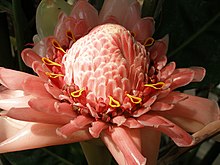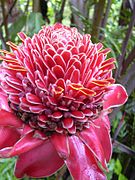Etlingera elatior
| Etlingera elatior | |
|---|---|

| |
| Scientific classification | |
| Kingdom: | Plantae |
| Clade: | Tracheophytes |
| Clade: | Angiosperms |
| Clade: | Monocots |
| Clade: | Commelinids |
| Order: | Zingiberales |
| Family: | Zingiberaceae |
| Genus: | Etlingera |
| Species: | E. elatior
|
| Binomial name | |
| Etlingera elatior (Jack) R.M.Sm.
| |
| Synonyms[2] | |
| |
Etlingera elatior (also known as torch ginger, among other names) is a species of herbaceous perennial plant in the family Zingiberaceae; it is native to Indonesia, Thailand, Malaysia and New Guinea.[2]
The showy pink flowers are used in decorative arrangements, and are an important ingredient in food across Southeast Asia.
Names
[edit]E. elatior is also known as "torch ginger", "ginger flower", "red ginger lily", "torchflower", "torch lily", "wild ginger", "Indonesian tall ginger" and "porcelain rose".[2] Other names are: "Philippine wax flower"; Sundanese: honje; Javanese: combrang; Indonesian: kecombrang or cekala (Sumatra); Standard Malay: bunga kantan; Sinhala: ගොඩ ඕලු (goda olu), ගොඩ නෙලුම් (goda nelum), or සිද්ධාර්ථ (siddartha); Chinese: 火炬姜 (pinyin: huǒjù jiāng); Spanish: boca de dragón; French: rose de porcelaine; Thai: ดาหลา (dala).[citation needed]
Description
[edit]The species grows as a pseudostem from a rhizome; it takes about 18–22 days for the first leaf to grow from the rhizome. The leafy shoot lasts for about 70 days and may reach a height of 3–4 metres.[3] Its leaves are leathery and grow around 3 feet (0.91 m) long with a central groove.[4] The fibers of Etlingera elatior are strong.[5]
Flower
[edit]The flower bud appears from the shoot after 30 days, it swells gradually and turns pink before blooming after more than 50 days. The inflorescence is made of 20-25 layers of floral bracts and 3-4 layers of involuntary bracts at full bloom; it may have 90-120 true flowers inside.[3]
Chemistry
[edit]From the leaves of E. elatior, three caffeoylquinic acids, including chlorogenic acid (CGA), as well as three flavonoids quercitrin, isoquercitrin and catechin, have been isolated.[6] Content of CGA was significantly higher than flowers of Lonicera japonica (Japanese honeysuckle), the commercial source.[7]
A protocol for producing a standardized herbal extract of CGA from leaves of E. elatior (40%) has been developed, compared to commercial CGA extracts from honeysuckle flowers (25%).[6]
Use
[edit]In North Sumatra (especially among the Karo people), the flower buds are used for a stewed fish dish called Arsik ikan mas (Andaliman/Sichuan pepper-spiced carp).[citation needed] In Bali, people use the white part of the bottom part of the trunk for cooking chilli sauce called "Sambal Bongkot", and use the flower buds to make chilli sauce called "Sambal Kecicang".
In Thailand, it is eaten in a kind of Thai salad preparation.[8] In Malaysia, the flower is an essential ingredient in cooking the fish broth for a kind of spicy sour noodle soup called "asam laksa" (AKA "Penang laksa"),[9] in the preparation of a kind of salad called kerabu and many other Malay dishes.[10] The fruit is also used in Indonesian cooking.[11]
In Karo, it is known as asam cekala (asam meaning 'sour'), and the flower buds, but more importantly the ripe seed pods, which are packed with small black seeds, are an essential ingredient of the Karo version of sayur asam, and are particularly suited to cooking fresh fish. In Sundanese, it is known as Honje.[citation needed]
Gallery
[edit]Similar species
[edit]- Alpinia galanga[12]
- Curcuma longa[13]
- Etlingera fulgens[12]
- Etlingera maingayi[12]
- Kaempferia galanga[12],[13]
See also
[edit]References
[edit]- ^ a b Riffle, Robert Lee (1998). The tropical look: an encyclopedia of dramatic landscape plants. Timber Press. p. 167. ISBN 978-0-88192-422-0.
- ^ a b c "Etlingera elatior L." Plant of the World Online. Royal Botanic Gardens, Kew. 2023. Retrieved 4 January 2022.
- ^ a b Choon, S.Y.; Ding, P. (2016). "Growth Stages of Torch Ginger (Etlingera elatior) Plant". Sains Malaysiana. 45 (4): 507–515. Retrieved 4 January 2023.
- ^ Vanzile, Jon (29 September 2022). Jessica, Wrubel (ed.). "How to Grow Torch Ginger". The Spruce. Dotdash Meredith. Retrieved 4 January 2023.
- ^ Quinaya, D.C.P.; d’Almeida, J.R.M. (2019). "Possibility of Exploring and Applying Wastes from Some Ornamental Plants (Elatior etlingera; Costus comosus; Heliconia bihai) as Sources of Natural Cellulosic Fibers". Journal of Natural Fibers. 17 (10): 1488–1496. doi:10.1080/15440478.2019.1581118.
- ^ a b Chan, E.W.C. (2009). “Bioactivities and chemical constituents of leaves of some Etlingera species (Zingiberaceae) in Peninsular Malaysia”. Ph.D. thesis, Monash University, 305 p., http://arrow.monash.edu.au/hdl/1959.1/149589 Archived 2012-12-03 at archive.today
- ^ Chan, E.W.C.; Lim, Y.Y.; Ling, S.K.; Tan, S.P.; Lim, K.K.; Khoo, M.G.H.; et al. (2009). "Caffeoylquinic acids from leaves of Etlingera species (Zingiberaceae)". LWT - Food Science and Technology. 42 (5): 1026–1030. doi:10.1016/j.lwt.2009.01.003.
- ^ "'ดาหลา' มาหาความอร่อย". คมชัดลึกออนไลน์ (in Thai). 2015-08-16. Retrieved 2022-11-02.
- ^ "Family Recipe for Asam Laksa". Retrieved 30 May 2021.
- ^ Tan, Florence (2018). Florence Tan's Timeless Peranakan Recipes. Marshall Cavendish International (Asia) Pte Ltd. ISBN 978-981-4794-03-9. OCLC 1132374857.
- ^ "Etlingera elatior (torch ginger)". cabi.org. Retrieved 19 January 2021.
- ^ a b c d Chan, E.W.C.; Lim, Y.Y.; Wong, L.F.; Lianto, F.S.; Wong, S.K.; Lim, K.K.; Joe, C.E.; Lim, T.Y.; et al. (2008). "Antioxidant and tyrosinase inhibition properties of leaves and rhizomes of ginger species". Food Chemistry. 109 (3): 477–483. doi:10.1016/j.foodchem.2008.02.016.
- ^ a b Chan, E.W.C.; Lim, Y; Wong, S; Lim, K; Tan, S; Lianto, F; Yong, M; et al. (2009). "Effects of different drying methods on the antioxidant properties of leaves and tea of ginger species". Food Chemistry. 113 (1): 166–172. doi:10.1016/j.foodchem.2008.07.090.











